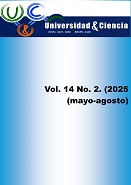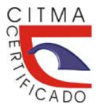Maintenance management from km 500 to 505,2 of the Central Highway
DOI:
https://doi.org/10.5281/zenodo.15345622Keywords:
deterioration, maintenance, pavementAbstract
Introduction: It is essential to have road infrastructure that ensures safe, comfortable and fluid circulation. However, over time and constant use, these pathways can deteriorate and cause significant problems for users. The road from km 500 to km 505,2, in the Province of Ciego de Avila, does not have good operating conditions, since it has several deteriorations, causing road safety problems. Objective: Develop a maintenance plan to preserve the road. Methods: The Pavement Condition Index Method (PCI) is implemented, determining the components that damage the infrastructure and the deterioration index. Results: The main injuries are identified as edge deterioration, potholes, crocodile skin, fine, transverse and longitudinal cracks, classifying the road as poor, so a maintenance plan is proposed taking into account the interventions that must be carried out as soon as possible to prevent these deteriorations from increasing. Conclusion: It is proven that the analyzed section does not fulfill its main functions of providing comfort and safety to users, showing a deficiency in the components of the road infrastructure.
Downloads
References
Al Qasimi, M., Al Zulayq, D. M. y Seifan, M. (2020). Mechanical and rheological properties of 3D printable cement composites. Recent Progress in Materials, 2(4), 1-14. https://doi.org/https://doi.org/10.21926/rpm.2004022
Burgmann, S. y Breit, W. (2024). Impact of crushed natural and recycled fine aggregates on fresh and hardened mortar properties. Construction Materials, 4(1), 37-57. https://doi.org/https://doi.org/10.3390/constrmater4010003
Cañarte Pico, D. S., Bravo Cedeño, Y. R. y Guerra Mera, J. C. (2023). Estudio comparativo del comportamiento de morteros de albañilería elaborados con varios tipos de agregados finos. Dominio de las Ciencias, 9(3), 1606-1623. https://doi.org/ https://doi.org/10.23857/dc.v9i3.3516
Gismera, S., Alonso, M., Palacios, M. y Puertas, F. (2020). Rheology of alkali-activated mortars: Influence of particle size and nature of aggregates. Minerals, 10(8), 726. https://doi.org/https://doi.org/10.3390/min10080726
Gu, H., Sun, J., Zhang, J., Xu, Y., Li, B. y Wu, W. (2020). Effect of material ratio on the performances in 3D cement printing and its optimization. AIP Advances, 10, 1-9. https://doi.org/https://doi.org/10.1063/5.0030186
Guendouz, M. y Boukhelkhal, D. (2018). Physical and mechanical properties of cement mortar made with brick waste. MATEC Web of Conferences, 149, 1-5. https://doi.org/https://doi.org/10.1051/matecconf/201814901077
Martínez García, R., Sánchez de Rojas, M. I., Morán del Pozo, J. M., Fraile Fernández, F. J. y Juan Valdés, A. (2021). Evaluation of mechanical characteristics of cement mortar with fine recycled concrete aggregates (FRCA). Sustainability, 13, 1-23. https://doi.org/https://doi.org/10.3390/su13010414
Muciño Vélez, A., Guillén Guillén, C. A., Tahuiton Mora, A. y Orozco Mendoza, E. (2022). Influencia de la arena en la resistencia mecánica del mortero empleando diferentes marcas de cemento. CIENCIA ergo-sum, 29(1), 1-9. https://doi.org/https://doi.org/10.30878/ces.v29n1a9
Muñoz Pérez, S. P., Díaz Sánchez, D. M., Gamarra Capuñay, E. E. y Chaname Bustamante, J. A. (2021). The influence of RCD in replacement of aggregates for the elaboration of concrete: A literary review. Ecuadorian Science Journal, 5(2), 107-120. https://doi.org/https://doi.org/10.46480/esj.5.2.111
Navarrete Seras, M., Martinez Molina, W., Chavez Garcia, H. L., Sanchez Calvillo, A., Arreola Sanchez, M., Borrego Perez, J. A. ... Alonso Guzman, E. M. (2023). Influencia de la proporción de arena en las propiedades físicas y mecánicas de morteros para la edificación. Revista de la Asociación Latinoamericana de Control de Calidad, Patología y Recuperación de la Construcción (ALCONPAT), 13(2), 158-174. https://doi.org/https://doi.org/10.21041/ra.v13i2.684
Norma Cubana (NC 175, 2002). Morteros de albañileria. Especificaciones. Oficina Nacional de Normalización, La Habana, Cuba.
Norma Cubana (NC 178, 2002). Áridos - ensayo granulométrico. Oficina Nacional de Normalización, La Habana, Cuba.
Norma Cubana (NC 657, 2008). Áridos para morteros de albañilería - Especificaciones. Oficina Nacional de Normalización, La Habana, Cuba.
Praveen Kumar, K. y Radhakrishna, X. X. (2020). Workability strength and elastic properties of cement mortar with pond ash as fine aggregates. 24(2), 1626-1633. https://doi.org/https://doi.org/10.1016/j.matpr.2020.04.484
Puig Martínez, R. A. (2014). Laboratorios de materiales de construcción. La Habana, Cuba: Facultad Ingeniería Civil, Instituto Superior Politécnico José Antonio Echeverría (CUJAE). https://www.researchgate.net/publication/321533840
Roux, C., Archez, J., Le Gall , C., Saadé, M., Féraille, A. y Caron, J.F. (2024). Towards sustainable material optimizing geopolymer mortar formulations for 3D printing: A life cycle assessment approach. Sustainability, 16(08), 1-20. https://doi.org/https://doi.org/10.3390/su16083328
Song, Y., Jingbin, Z., Xuehui, A., Bing, Q., Wenqiang, L., Dejian, S. y Pengfei, L. (2021). The effect of sand type on the rheological properties of self-compacting mortar. Buildings, 11, 1-17. https://doi.org/https://doi.org/10.3390/buildings11100441
Tiang, L., Nogueira, R., De Brito, J. y Jiaping, L. (2023). Quantitative analysis of the influence of fine aggregate's grading on mortar's rheology. Journal of Materials Research and Technology, 25, 310-318. https://doi.org/https://doi.org/10.1016/j.jmrt.2023.05.236
Vandhiyan, R., Vijay, T. J. y Manoj Kumar, M. (2021). Effect of fine aggregate properties on cement mortar strength. Materialstoday: Proceedings, 37(2), 2019-2026. https://doi.org/https://doi.org/10.1016/j.matpr.2020.07.498
Downloads
Published
How to Cite
Issue
Section
License
Copyright (c) 2025 Universidad & ciencia

This work is licensed under a Creative Commons Attribution-NonCommercial-ShareAlike 4.0 International License.





















